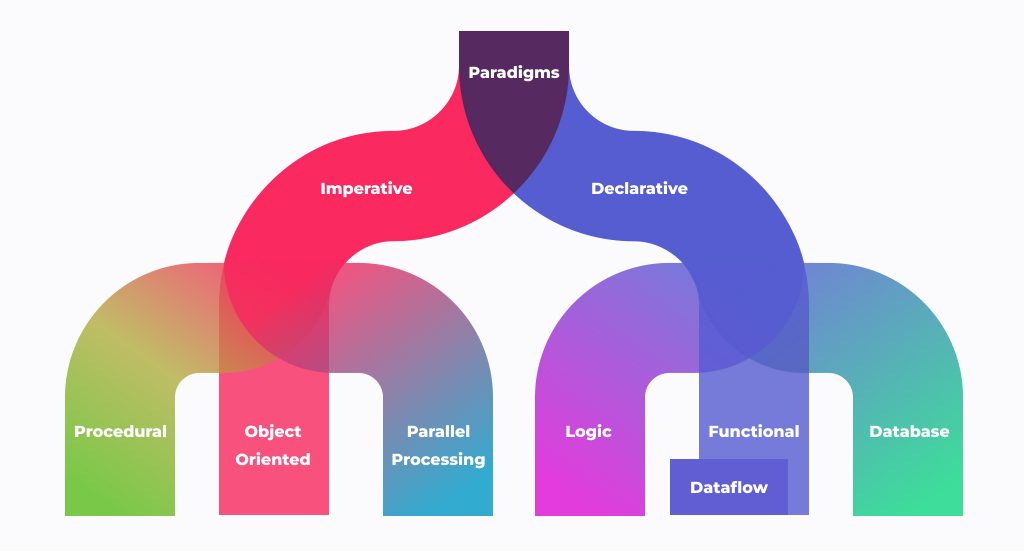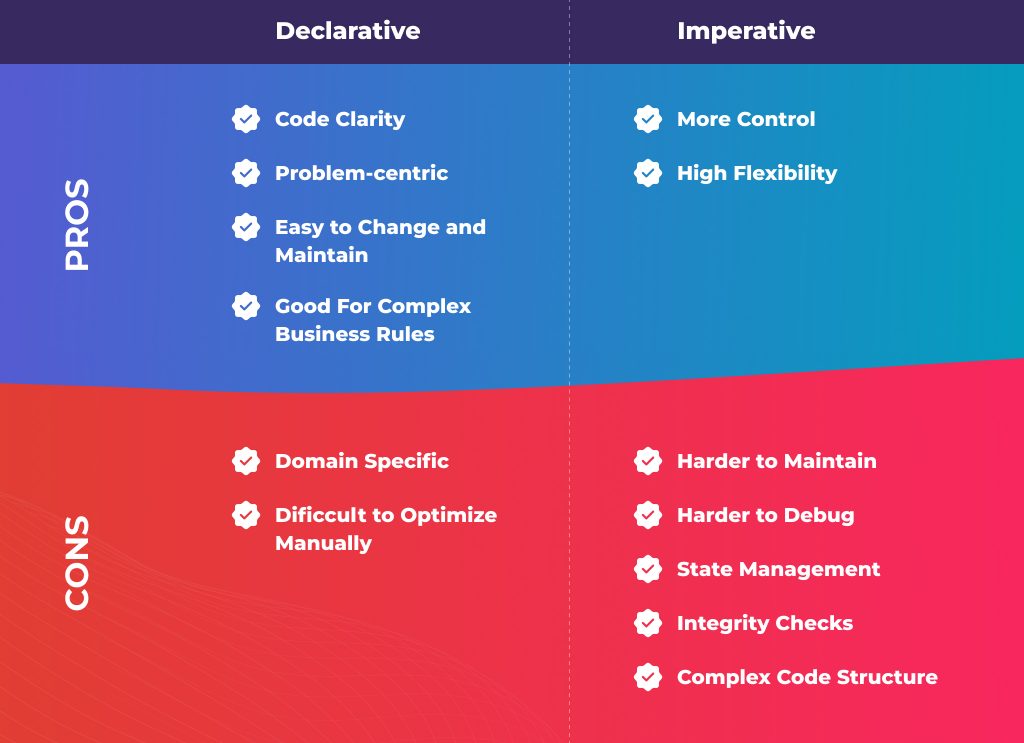Imperative vs Declarative Programming. What are Their Major Features, Pros, and Cons?
Currently, there's no shortage of programming languages. On the software development planet, industry veterans peacefully coexist with newcomers. For example, there's growing interest in making Rust (appeared in 2015) a second language to C (appeared in 1972) for the Linux kernel. Also, something new appears regularly. As soon as the whole world seemed to agree that Python is the best programming language, Mojo appeared to address Python's performance and deployment limitations. The world of programming is quite versatile and bursting with innovation. Whether you're an experienced web developer or someone who writes code for fun, you'll find the language that best suits you.
However, some things are above a particular language's syntax and other features. The programming paradigm determines the approach to solving a problem using code. Many modern languages support various paradigms, so adherence to a specific problem-solving strategy won't necessarily lead to the necessity to learn a new one. Today, we'll consider the difference between imperative and declarative paradigms to help you fill the gap between basic language constructs and how they help solve problems.

Imperative Programming. Determine How Things Work
Imperative programming's roots can be traced back to the early days of computing. It focuses on using code to specify the steps required to accomplish a task. This approach revolves around instructions and statements, where the developer explicitly outlines a series of commands for the computer to execute. The imperative technique emphasizes how a program should achieve its goals through a detailed sequence of steps. Here, statements mutate the program's state, altering variables, objects, and data structures.
At the core of imperative programming lies the concept of control flow. It implies that developers can use conditional statements such as if-else and switch-case in code to direct the program's execution based on specific conditions. Loops, like for and while, enable repetitive execution of instructions until particular criteria are met. This imperative control over the flow allows the crafting of intricate algorithms and precise logic.
In an imperative programming paradigm, assignments and mutations explicitly modify a program's state. Variables serve as mutable storage units, holding values that can change throughout execution. Developers that use the imperative approach can assign new values, perform arithmetic operations, and update data structures within the program. Functions and procedures can be used to design reusable code. These subroutines encapsulate a set of instructions that can be called from different parts of the program built following the imperative way.
Let's take a look at a tiny Python program to see how imperative programming works:
# Generate a list of items
numbers = [23, 45, 12, 67, 89, 34, 56]
# Initialize the maximum variable with the first element
max_num = numbers[0]
# Iterate through the list starting from the second element
for num in numbers[1:]:
if num > max_num:
max_num = num
# Print the maximum value
print("The maximum number is:", max_num)
In this code, we manually iterate over the list of numbers, compare each number with the current maximum, and update the maximum variable if a larger number is found. Later, we’ll see how the same task can be performed following the declarative paradigm. Among the languages that support imperative programming, we can note Java, C, Python, Ruby, and PHP.
Read Also Python vs JavaScript: Main Differences, Performance Comparison, and Areas of Application
Declarative Programming. Focus on The Result
Unlike imperative, declarative programming implies that developers focus on writing code that describes what needs to be achieved rather than explicitly specifying how to accomplish it. With its emphasis on abstraction and high-level descriptions, declarative programming offers a relatively fresh perspective that simplifies the development process.
In this scenario, developers express the desired outcome or goal without diving into the details of how it should be achieved. Rather than explicitly outlining a series of instructions for the computer to execute, declarative programming focuses on defining relationships and constraints between different parts of the program.
One of the critical elements of this programming technique is the use of declarative languages or frameworks to write code. They provide developers with specialized syntax and constructs designed to express the desired outcome concisely and expressively. They abstract away the low-level implementation details, allowing developers to focus on the higher-level logic.
A prime example of declarative programming is SQL (Structured Query Language), commonly used to interact with databases. Instead of explicitly defining step-by-step instructions, developers use code to declare the desired data and relationships. The database engine will handle the underlying operations, allowing the developer to focus on how to represent data intuitively in a BI solution, for example.
Read Also Working with Multiple Databases Simultaneously Using NestJS and TypeORM
Another feature of declarative programming is code immutability. Rather than modifying the program's state through assignments and mutations, declarative programs emphasize creating new values and structures based on existing ones. It promotes a functional code writing style, where functions act as pure transformations, taking input and producing output without side effects.
Declarative programming encourages using higher-order functions and abstractions to simplify complex operations. By breaking down a problem into smaller, reusable functions, developers can compose these functions to create a solution. This composability enables code reuse and modularity.
Let’s return to the example from the previous chapter and see how we can solve the same problem using a declarative approach:
# Generate a list of items
numbers = [23, 45, 12, 67, 89, 34, 56]
# Use the max() function to find the maximum value
max_num = max(numbers)
# Print the maximum value
print("The maximum number is:", max_num)
In this declarative programming example, we use the built-in max() function, which takes a list of numbers and returns the maximum value. This code expresses the intention to find the maximum number without explicitly defining the iteration and comparison steps. Here you just say: “Ok, computer, can you provide me with the results of these operations, please?” And everything works. Or not. Depends on your coding skill. As an example of declarative languages, we can name SQL or Lisp. However, it’s important to remember that Python, for example, supports both approaches.
Pros and Cons of Different Approaches

Our examples show how you can reach the same destination following two different routes. Moreover, imperative programming looks more labor-intensive since it requires more code. The question is, what reasons can dictate you to choose one or the other? Let's find out.
Imperative programming advantages. One of the strengths of imperative programming lies in its precise and detailed nature. It gives developers fine-grained control over the program's execution and state, allowing them to define the desired behavior precisely. This level of control is particularly advantageous in scenarios that require low-level hardware interactions or complex algorithms.
Imperative programming disadvantages. As programs grow in size and complexity, managing mutable states and tracking changes can become cumbersome. Debugging the code can be more intricate, as errors can arise from unexpected state modifications. Additionally, parallelizing imperative code can be complex due to potential data dependencies and shared mutable states.
Declarative programming advantages. This approach works great in scenarios where complex business rules or logic must be expressed concisely. By separating the "what" from the "how," developers can focus on the problem rather than implementation details. This abstraction and separation of concerns promote clarity and make code easier to read and analyze.
Declarative programming disadvantages. As with anything else, this way of writing code is not a one-size-fits-all solution. While it excels in specific domains, it may not be suitable for performance-critical applications or scenarios requiring low-level control. Additionally, debugging declarative programs can be challenging due to the abstraction and lack of explicit control flow.
Conclusions
One of the most intriguing things about writing the code is that this craft involves more than making sure the input data matches the results. The way of structuring it, for example, is a separate art form. Understanding such concepts as various paradigms and especially the ability to switch between them if needed is one of the hallmarks of a professional in the industry.
